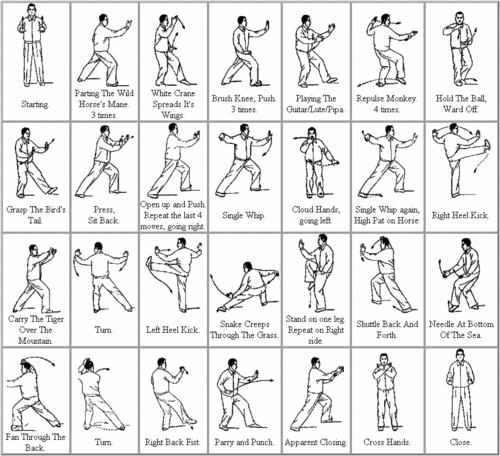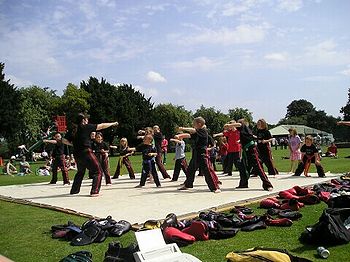From The Peopling of New York City
Contents |
Martial Arts
The early Greeks were the first civilization to record the practice of a martial art. Their practice, known as Pankration, which means the art of complete strength, is the first recognized organized form of combat and involves many different techniques such as wrestling, grappling, and boxing. The earliest records of this sport date back to 700 BC, but it is very likely that the sport was practiced even earlier without having been recorded. Interestingly, Pankration is still practiced in Greece.
Japan soon developed its own version of martial arts, which no longer focused on combat like Pankration, but instead on breathing exercises. Eventually migratory Chinese experts influenced these styles, and the Asian sports common today were born. There are over 200 individual styles grouped together under the umbrella title of martial arts. These styles are practiced all over the world, and slight changes can exist from dojo to dojo (a studio in which martial arts is practiced). As of today, over 100 million people worldwide practice some form of the sport – will you be next?
Modern Fusion of Styles
Nowadays with the fusion of many martial arts styles, one school can easily offer all of the following:
Self-defense Skills: A Krav Maga program, which offers real world defensive tactics designed to quickly develop the ability to protect yourself and your loved ones.
Striking Skills: A Muay Thai Kickboxing program, which will bring striking skills (punching, kicking, knees, elbows) to the highest level possible. This is the art that most of the UFC Fighters trust to help them win their battles.
Grappling Skills: A submission grappling and Brazilian Jiu Jitsu program, which will help develop ground game for both self-defense and for competition. These arts have been made popular by almost every UFC Fighter and are as practical as you can get.
The following photographs demonstrate this fusion – the students are all from one school, but can be seen displaying multiple styles.
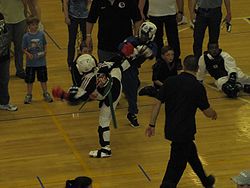
| 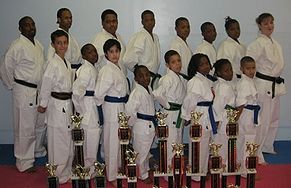
| 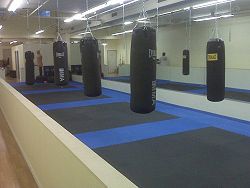
| 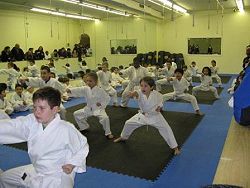
|
In the Media
Many schools of martial arts discuss what it means to be a martial artist from the inside out. More than just learning and repeating the moves, a true master of his sport must have the mindset of one. Our Western TV/movie centered culture does much to offset these ideals by imposing many of its own values.
One example of this is a popular long-lived children’s show, “Power Rangers.” These rangers act as costumed heroes, who train and fight their evil enemies. Another series, which was popular at the start of the decade, is "Jackie Chan Adventures," which made a cartoon out of a real situation. Although the events were made up, the mythical stories surrounding each episode shed much light on the cultural background of where this martial arts stems from. The show centered on the Chinese zodiac and Chi magic, which are both important elements in Chinese culture.
More than just entertainment, these martial arts shows have much influence and cultural relevance. Popular movies showcasing this Chinese culture through a martial arts lens include Enter the Dragon, starring Bruce Lee, The Shaolin Temple, starring Jet Li, and the famous Crouching Tiger, Hidden Dragon.
Martial Arts in New York City
The diversification of students practicing martial arts in NYC has become very widespread. An interview with martial arts dojo owner and instructor, Willie Marshall, proved that practitioners are becoming younger as the years go on, and are performing the sport more so for fun than perfecting the art. Parents are sending their kids to classes to learn discipline, while participating in a safe and organized sport as an after-school activity. More women are signing up as well, but their focus is often self-defense.
In effect, because of the increase in the number of students and the decrease in their dedication to the sport, earning a black belt has become simpler – belts are being awarded through time, not necessarily through mastery of skill. Conclusion: in NYC there are more black belts, but fewer true masters.
Tai Chi
The form of martial arts that can be found practiced outdoors in New York City parks is called Tai Chi Chuan, usually shortened to just Tai Chi. The direct translation of this word is "supreme ultimate fist," which is interpreted to mean a practiced form of life energy. Unlike its brothers and sisters, the other forms of defense, Tai Chi is practiced mostly for health purposes as a type of martial arts therapy.
Developed from many Chinese philosophies such as Taoism and Confucianism, Tai Chi is a solo sport. When performing the movements, one must be very centered, relaxed, and in tune with his breathing. The movements are all slow and fluid to ensure concentration and prevent any ailments such as muscle pulls. In NYC, many groups of individuals, usually Asians, gather in parks in the morning and start their day with a Tai Chi routine. Through the years many different styles and routines have been developed, but they all center about the concepts of posture and movement. No extra equipment is necessary. The following is a chart of some moves that students do.
Tai Chi in New York City
Because of Tai Chi’s focus on health and meditation through the way of a martial art, classes have become popular in recent years. Usually the people found practicing in parks are older, doing their activity early in the morning as an exercise. Some groups meet as early as six in the morning to begin their routines. Parks however, are not the only places in NYC where the sport is found; hospitals, community centers, senior centers, and clinics all offer some form of Tai Chi.
The fluidity of the sport allows older people to practice and stay or get healthy without hurting themselves with the rapid movements of other similar sports such as combative martial arts or gymnastics. The sport can also be complemented on its aesthetic appeal to viewers. The following is a photograph of a class practicing in a park.

